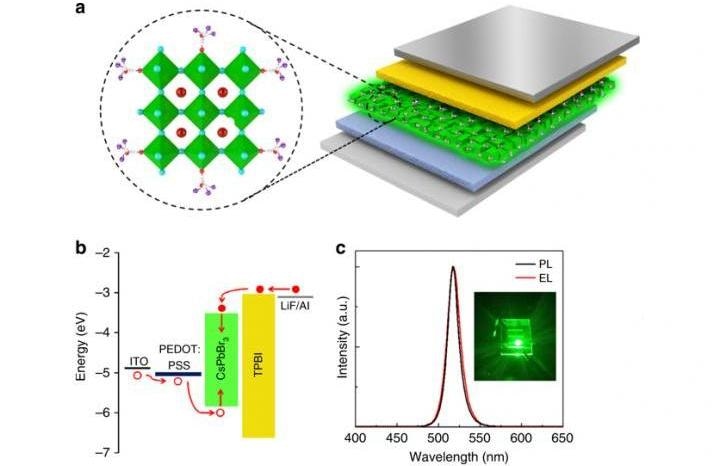Feb 14 2019
Metal halide perovskites are considered as the futuristic materials for light emitting devices (LEDs).
 (a) Device structure and a corresponding cross-sectional TEM image of the multi-layer PeLEDs; (b) Schematic flat-band energy diagram of the PeLED; (c) Normalized photoluminescence spectrum of the CsPbBr3 film, and electroluminescence spectrum of the PeLED at an applied voltage of 5.5 V. (Image credit: City University of Hong Kong)
(a) Device structure and a corresponding cross-sectional TEM image of the multi-layer PeLEDs; (b) Schematic flat-band energy diagram of the PeLED; (c) Normalized photoluminescence spectrum of the CsPbBr3 film, and electroluminescence spectrum of the PeLED at an applied voltage of 5.5 V. (Image credit: City University of Hong Kong)
As part of a recent collaborative study co-headed by the researchers from the City University of Hong Kong, an efficient and innovative fabrication technique has been developed for making all-inorganic perovskite films that have better stability and optical properties, thereby facilitating the development of low-cost and high-color-purity perovskite LEDs (PeLEDs) with a longer operational life.
PeLEDs, which are an emerging light-emitting technology, offer the benefits of high light quality, low production cost, and high energy efficiency. Recently, metal halide (i.e., compounds of metals with chlorine, bromine, or iodine) perovskites have gained considerable attention as prospective materials for solution-processed LEDs, due to their superior optical properties, such as easy color tunability and saturated emission colors.
Specifically, perovskites that are based on inorganic cesium cations, such as CsPbX3 (where X can be chlorine, bromine, or iodine), display better chemical and thermal stability than the organic-inorganic “hybrid” metal halide perovskites, and can thus offer the basis for high-performance LEDs that have reasonable operational stability. However, inorganic PeLEDs developed earlier exhibited comparatively unsatisfactory electro-luminescence performance owing to their large perovskite grain sizes.
Currently, a research team from the City University of Hong Kong and at Shanghai University in mainland China has created an efficient fabrication technique to manufacture smooth inorganic perovskite films that have considerably improved performance and stability. The outcomes of the study, titled “Trifluoroacetate induced small-grained CsPbBr3 perovskite films result in efficient and stable light-emitting device,” have been reported in the latest issue of the scientific journal Nature Communications.
The researchers have discovered that rapid crystallization of small-grained CsPbBr3 perovskite crystals, which in turn forms pinhole-free and smooth perovskite films, can be achieved by using cesium trifluoroacetate (TFA) as the cesium source in the one-step solution coating, rather than cesium bromide (CsBr) that is usually used. This is due to the fact that the interaction of TFA anions with the Pb2+ cations contained in the CsPbX3 precursor solution considerable enhances the crystallization rate of perovskite films and inhibits surface defects.
Consequently, the researchers have managed to manufacture stable and efficient green PeLEDs using these films, with a maximum current efficiency of 32.0 cd A−1 that corresponds to an external quantum efficiency of 10.5%—a level that is normally regarded as acceptable in existing PeLEDs.
Most significantly, the all-inorganic perovskite LEDs developed using these films exhibited a record operational life. Their half-life was found to be more than 250 hours at an initial luminance of 100 cd m−2, which is a 17 times increase in operational life compared to CsBr-derived PeLED.
Our study suggests that the high color-purity and low-cost all-inorganic lead halide perovskite films can be developed into highly efficient and stable LEDs via a simple optimization of the grain boundaries. I foresee significant application potential of such films, as they are easy to fabricate and can be easily deposited by printing to realise various optoelectronic devices.
Andrey Rogach, Chair Professor of Photonics Materials, City University of Hong Kong
Rogach is also one of the corresponding authors of the study. Professor Yang Xuyong from Shanghai University is the other corresponding author of the study. Wang Haoran from Shanghai University and Zhang Xiaoyu, a former visiting research student at the City University of Hong Kong, working now as a postdoc at Jilin University, are the first authors of the study.